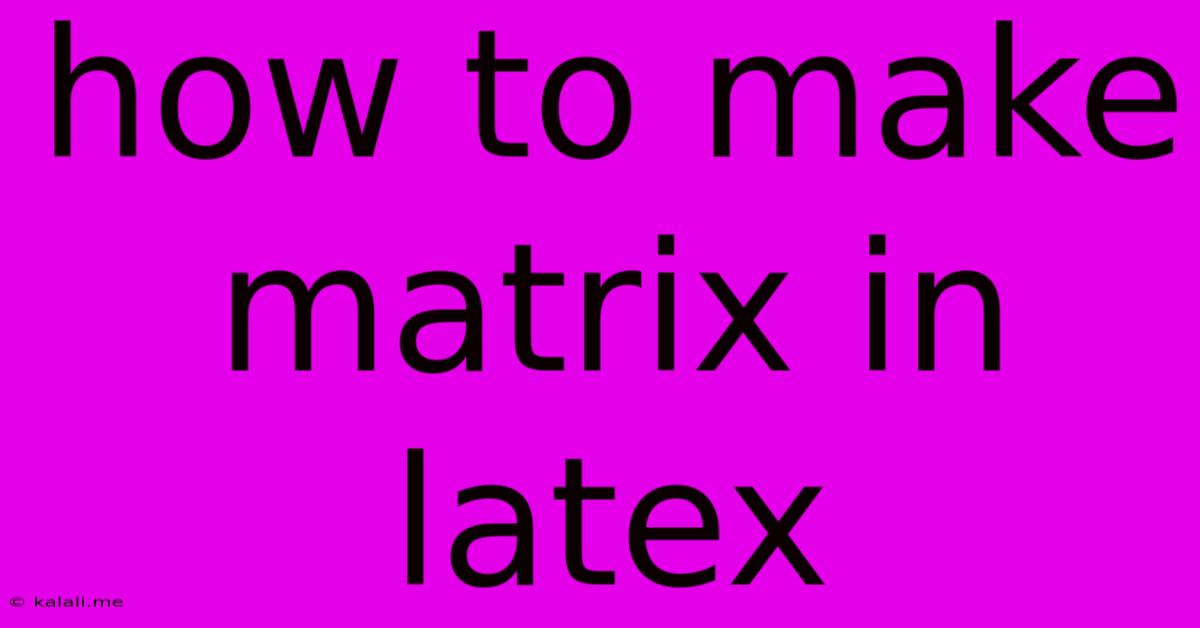How To Make Matrix In Latex
Kalali
Jun 08, 2025 · 2 min read

Table of Contents
How to Make a Matrix in LaTeX: A Comprehensive Guide
Creating matrices in LaTeX is straightforward once you understand the basic syntax. This guide covers various matrix types, from simple to complex, ensuring you can effectively present your mathematical expressions. This guide will cover everything from basic matrix creation to more advanced techniques, helping you present your mathematical work clearly and professionally.
Why Use LaTeX for Matrices?
LaTeX offers superior typesetting capabilities compared to other word processors. Matrices created in LaTeX are visually appealing, professionally formatted, and easily integrated into academic papers, reports, and presentations. The resulting output is far cleaner and more readable than what you could achieve in a standard word processor.
Basic Matrix Structure
The fundamental structure for creating a matrix in LaTeX uses the \begin{matrix} ... \end{matrix} environment. Within this environment, you'll input your matrix elements, separated by ampersands (&) and rows separated by double backslashes (\\).
Here's a simple example of a 2x2 matrix:
\begin{matrix}
a & b \\
c & d
\end{matrix}
This will render as:
$\begin{matrix} a & b \ c & d \end{matrix}$
Adding Brackets and Delimiters
The basic matrix environment doesn't include brackets or delimiters. To add these, you need to use different environments:
pmatrix: Parentheses( )bmatrix: Square brackets[ ]Bmatrix: Braces{ }vmatrix: Vertical bars| |(for determinants)Vmatrix: Double vertical bars|| ||(for norms)
For instance, to create a matrix with square brackets, use:
\begin{bmatrix}
1 & 2 \\
3 & 4
\end{bmatrix}
This renders as:
$\begin{bmatrix} 1 & 2 \ 3 & 4 \end{bmatrix}$
Creating Larger Matrices
The same principles apply to larger matrices. Just add more rows and columns as needed, maintaining the & and \\ separators. For example, a 3x3 matrix:
\begin{vmatrix}
1 & 2 & 3 \\
4 & 5 & 6 \\
7 & 8 & 9
\end{vmatrix}
This produces:
$\begin{vmatrix} 1 & 2 & 3 \ 4 & 5 & 6 \ 7 & 8 & 9 \end{vmatrix}$
Adding Dots for Implicit Elements
For very large matrices, you can use dots to represent omitted elements:
\begin{pmatrix}
a_{11} & a_{12} & \cdots & a_{1n} \\
a_{21} & a_{22} & \cdots & a_{2n} \\
\vdots & \vdots & \ddots & \vdots \\
a_{m1} & a_{m2} & \cdots & a_{mn}
\end{pmatrix}
This will produce a matrix with ellipses representing the missing elements:
$\begin{pmatrix} a_{11} & a_{12} & \cdots & a_{1n} \ a_{21} & a_{22} & \cdots & a_{2n} \ \vdots & \vdots & \ddots & \vdots \ a_{m1} & a_{m2} & \cdots & a_{mn} \end{pmatrix}$
Nested Matrices
You can even nest matrices within each other for more complex expressions:
\begin{bmatrix}
A & B \\
C & \begin{pmatrix}
x & y \\
z & w
\end{pmatrix}
\end{bmatrix}
This allows for sophisticated mathematical representation.
Remember to compile your LaTeX code using a suitable compiler (like pdflatex) to generate the rendered output. With these techniques, you can create clear and professional-looking matrices in your LaTeX documents. Experiment with the different environments and commands to find the best way to represent your mathematical data.
Latest Posts
Latest Posts
-
How Old Are Romeo And Juliet In The Play
Jun 09, 2025
-
Meaning Of See You On The Flip Side
Jun 09, 2025
-
Find The Region Common To Both Circles Area
Jun 09, 2025
-
What Is Expression Of Interest Job Mean
Jun 09, 2025
-
How To Feed 2 Month Old Pigeons Food
Jun 09, 2025
Related Post
Thank you for visiting our website which covers about How To Make Matrix In Latex . We hope the information provided has been useful to you. Feel free to contact us if you have any questions or need further assistance. See you next time and don't miss to bookmark.